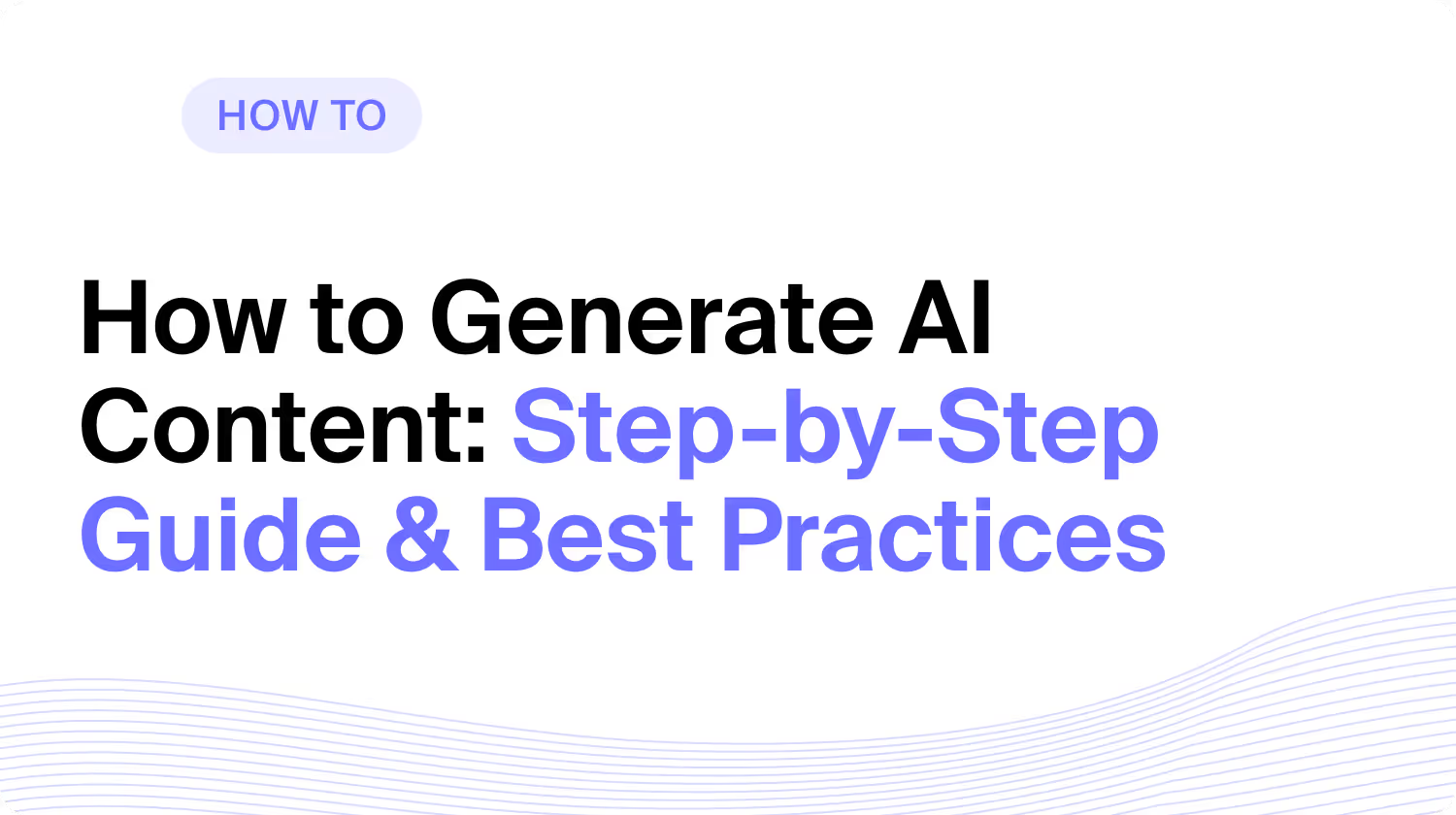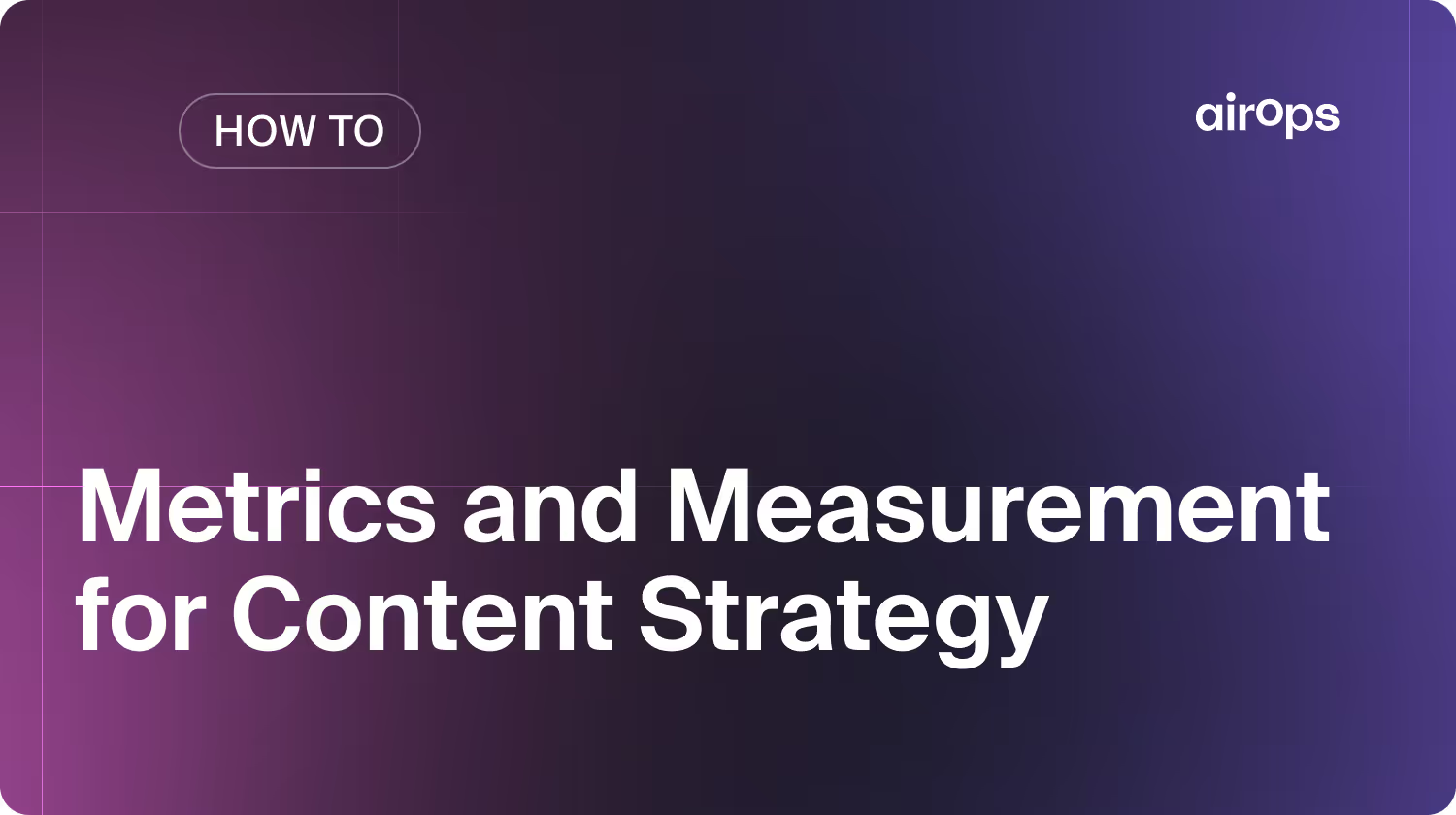How to Generate AI Content: Guide & Best Practices

AI content generation works best when guided by clear goals, structured prompts, and human review.
Optimizing for both SEO and AEO ensures your AI-generated content performs across search engines and LLMs.
This article provides a complete, proven framework for generating AI content that’s scalable, optimized, and aligned with brand and performance goals.
AI content generation has evolved from a novelty to a necessity for modern content teams. Whether you’re managing a blog, e-commerce catalog, or knowledge base, large language models (LLMs) and AI-powered tools now offer a faster, more scalable way to create high-quality content.
But quality at scale isn’t automatic.
To get real results, teams need a structured workflow—one that combines clear goals, detailed prompts, human oversight, and optimization for both traditional SEO and answer engines like ChatGPT and Google AI Overviews.
What is AI Content Generation?
AI content generation refers to the use of artificial intelligence tools—typically powered by large language models (LLMs)—to automatically create written, visual, or multimedia content. These tools analyze patterns in language and data to generate content that mimics human writing.
AI can generate a wide range of content types, including:
- Blog posts and articles
- Product descriptions
- Social media captions
- Email copy
- Customer support responses
- SEO-optimized landing pages
According to research from MIT Sloan, AI excels at tasks that are structured, repeatable, and data-driven. When paired with human oversight, it enables faster production of high-quality content while preserving brand standards and accuracy.
Is AI-Generated Content Detectable?
Most AI detectors are unreliable and prone to false positives. Well-edited AI content is difficult to distinguish from human writing. Focus on delivering value and quality to your readers.
Why Use AI to Generate Content?
AI content generation enables faster, more scalable content production without sacrificing consistency or brand voice. For businesses producing large volumes of content—like e-commerce, SaaS, or media—AI tools help meet demand while reducing manual effort.
Key Benefits of Using AI for Content Creation:
- Scale efficiently: Generate hundreds of articles, descriptions, or emails in a fraction of the time it would take manually.
- Maintain brand consistency: Train AI tools on tone, style, and guidelines to keep messaging uniform across channels.
- Reduce costs: Automate repetitive content tasks to free up resources for strategy and innovation.
- Accelerate experimentation: Quickly test new formats, headlines, or landing pages with minimal overhead.
- Stay competitive: According to McKinsey, 71% of organizations are already using generative AI to improve marketing performance and content delivery.
AI is especially effective for structured content formats—like product descriptions, how-to articles, or FAQs—where it can reliably follow patterns and templates. However, human review is still essential to ensure accuracy, tone, and originality.
What Types of Content Can AI Generate?
AI tools can generate a wide range of content formats, including blog posts, product descriptions, social media copy, and email newsletters.
Some advanced platforms also support multimedia formats through features like AI text to speech, allowing written content to be instantly converted into natural-sounding audio for podcasts, accessibility tools, or marketing videos.
How to Generate Content with AI
Generating high-quality AI content requires a structured workflow, clear goals, and consistent oversight. Follow these steps to ensure your content is useful, on-brand, and optimized for AI visibility.
1. Define Your Content Goals and Target Audience
Clear goals and audience insights form the foundation of every successful AI content workflow. Without them, even high-quality output may miss the mark in relevance, tone, or intent.
Start by answering:
- What’s the primary goal of this content? (e.g., drive traffic, capture leads, educate users, improve SEO, support product adoption)
- What stage of the funnel is the audience in? (awareness, consideration, decision)
- Who are you writing for? (demographics, roles, pain points, motivations)
- What action should the reader take? (e.g., sign up, click through, share, buy)
Knowing your audience helps tailor voice, structure, and depth of content. Knowing your goals ensures alignment with your marketing strategy and performance metrics.
Example: A blog post for “first-time e-commerce founders researching SEO” should use simple language, define technical terms, and focus on practical takeaways—very different from a guide aimed at enterprise CMOs.
Defining the context behind your goals and audience ensures your AI content is not just coherent—but strategically effective.
2. Choose the Right AI Platform
Selecting the right AI content generation tool is critical to achieving your content goals at scale. Different platforms offer different strengths—some are better for flexibility, others for automation, SEO optimization, or long-form control.
When evaluating AI platforms, consider:
- Content quality and consistency: Does the tool support your tone, brand voice, and formatting requirements?
- Prompt customization and chaining: Can you engineer detailed workflows or build layered prompts?
- Workflow integration: Does it connect with your CMS, analytics tools, or publishing stack?
- Output formats: Does it support structured formats like FAQs, how-to guides, or e-commerce templates?
- Advanced features: Look for SEO optimization, real-time data access, or support for AEO requirements (structured output, fact-first formatting, citation control).
The right platform depends on your team’s needs, content volume, and quality expectations. Align your tool choice with both strategic goals and operational constraints.
3. Write an Effective Content Brief
A well-crafted content brief gives the AI the context it needs to generate accurate, relevant, and on-brand content. The more precise your input, the better the output.
Include these core elements in every brief:
- Content type: e.g., blog post, product description, FAQ section, landing page
- Primary topic or headline: What the content should focus on
- Target keywords: Main and semantic variations to guide relevance
- Intended audience: Who the content is for (persona, industry, role)
- Tone and voice: Formal, conversational, authoritative, playful, etc.
- Length or format constraints: Word count, sections, or structural expectations
- Internal resources or examples: Links to past content or reference materials
AEO Tip: Use bullet formatting in your brief to improve prompt clarity and help LLMs parse each instruction distinctly.
A clear brief reduces ambiguity, minimizes editing time, and ensures your AI-generated content meets both brand and SEO standards from the start.
4. Use Prompt Engineering Techniques
Effective prompt engineering is the key to generating accurate, high-quality AI content. The structure and clarity of your prompts directly impact how well the AI understands and executes your request.
To improve AI output using prompt engineering:
- Be explicit and detailed: Include content type, target audience, tone, format, and keyword focus within your prompt.
- Use step-by-step or layered instructions: Break complex content tasks into smaller, manageable steps using prompt chaining.
- Test and iterate: Experiment with prompt phrasing and order to refine the consistency and quality of the results.
- Include examples or structural patterns: Providing models or outlines helps LLMs align with your expectations.
- Document your best-performing prompts: Build a library of tested prompts that can be reused or adapted across campaigns.
According to Zapier, prompt quality is one of the most important factors in generating useful, brand-aligned AI content.
5. Review and Edit the Output
Human review is essential to ensure accuracy, quality, and alignment with your brand. AI tools can produce content quickly, but they can make factual errors, miss nuance, or generate off-brand phrasing.
Before publishing:
- Fact-check statistics, names, and claims against reliable sources.
- Refine the tone and voice to match your brand guidelines.
- Ensure logical flow and structure, especially in long-form content.
- Eliminate repetition or vague phrasing that may weaken clarity.
According to MIT Sloan, human oversight is critical in maintaining credibility and editorial standards when using AI content tools.
6. Optimize for SEO and AEO (Answer Engine Optimization)
To ensure your content performs in both search engines and AI-powered platforms, you must optimize for both SEO and AEO.
Traditional search relies on keyword relevance and site structure, while answer engines like ChatGPT, Perplexity, and Google AI Overviews prioritize clarity, extractability, and factual authority.
To optimize for both:
- Lead with fact-first sentences: Start paragraphs and headings with the core answer or insight—this improves LLM citation likelihood.
- Use semantic HTML structure: Organize content with proper H1, H2, and H3 formatting to signal hierarchy and intent.
- Integrate target and semantic keywords naturally across headings, introductions, and body content.
- Add structured data (schema) where applicable, such as HowTo, FAQ, or Article schema, to help search engines and answer engines parse meaning.
- Cite authoritative sources like academic research, Google documentation, or industry leaders to strengthen trust signals.
- Link to related internal content using descriptive anchor text to reinforce topical depth and site architecture.
Well-optimized content not only ranks in SERPs but is also more likely to be selected, quoted, or summarized by LLMs in AI overviews and chat responses.
7. Publish, Promote, and Measure Performance
Publishing is just the beginning—distribution and performance tracking are what turn content into results. Once your AI-generated content is reviewed and optimized, focus on visibility and continuous improvement.
To maximize impact:
- Distribute content across multiple channels, including your website, blog, email list, social media, and third-party platforms.
- Use automation tools and workflows (like AirOps or Zapier) to streamline publishing and syndication.
- Add tracking parameters (UTMs) and integrate with analytics platforms to monitor engagement and conversions.
- Measure key performance indicators (KPIs) such as traffic, time on page, bounce rate, backlinks, and LLM citations (e.g., Perplexity sources, ChatGPT mentions).
- Continuously refine content based on content metrics and performance data—update underperforming posts, expand high-performing ones, and test new formats.
By treating content as a living asset, you can amplify reach, improve rankings, and increase the likelihood of LLM inclusion and citation over time.
Best Practices for AI Content Generation
To create AI content that is accurate, effective, and search-visible, follow these essential best practices:
1. Always Edit Before Publishing
AI tools can produce coherent content, but they often make factual errors or miss the mark on brand tone. Human review is essential to ensure quality, voice consistency, and strategic alignment.
2. Check for Factual Accuracy and Data Integrity
AI models may fabricate statistics, outdated claims, or incorrect figures. Always verify numbers, quotes, and sources—especially for data-driven or regulated content.
3. Confirm All Links and Citations
AI-generated links may be outdated, broken, or entirely fictional. Review internal and external links for accuracy and ensure citations support the claims made.
4. Avoid Low-Quality or Over-Optimized Output
Google may penalize shallow, repetitive, or keyword-stuffed content—even if it’s AI-generated. Focus on creating useful, informative content that reflects E-E-A-T principles (Experience, Expertise, Authoritativeness, Trustworthiness).
5. Choose the Right Tool for Your Needs
Not all content generation needs the same level of structure. Choosing between a standalone LLM and a workflow platform depends on your scale, team, and content type.
- Use a standalone LLM (like ChatGPT or Claude) when you’re creating one-off content, ideating topics, or refining drafts. This is ideal for individuals or small teams working on ad hoc content needs.
- Use a workflow builder when you need consistency, collaboration, and automation at scale. Workflow platforms let you define structured prompts, integrate with CMS tools, and enforce quality controls across high-volume content operations.
If your content needs to follow repeatable formats or and be produced across a team, a workflow builder offers the control and scalability a standalone LLM interface can’t.
6. Edit for Tone and Voice
Always revise for voice, flow, and clarity to ensure the final output reflects your brand. For practical techniques, explore our guide on how to make AI writing sound more human.
Scale Smarter with AI-Driven Content Workflows
Generating high-performing AI content isn’t just about using the right tools—it’s about building the right system.
With a structured workflow, clear goals, and human oversight, you can consistently produce content that ranks, converts, and earns visibility across search and answer engines.
By applying prompt engineering, aligning your platform to your needs, and optimizing for both SEO and AEO, your team can generate content that’s not only scalable—but strategic.
How AirOps Helps Teams Generate AI Content at Scale
AirOps is designed for content teams that need to scale intelligently—without sacrificing quality. Whether you’re producing 10 blog posts or 1,000 product descriptions, AirOps enables consistent, on-brand output through repeatable workflows, structured prompts, and seamless CMS integration.
AirOps can help teams:
- Create reusable prompt templates for consistent, high-quality output
- Build structured workflows that integrate with your CMS, analytics, and review processes
- Align content with SEO and AEO standards using automation and human-in-the-loop review
- Maintain brand voice across all formats and channels
👉 Book a strategy session to see how AirOps can streamline your AI content operations and help you scale with confidence.
Win AI Search.
Increase brand visibility across AI search and Google with the only platform taking you from insights to action.
Get the latest on AI content & marketing
Get the latest in growth and AI workflows delivered to your inbox each week
.avif)




